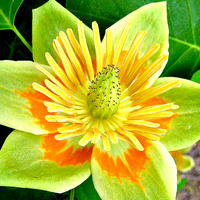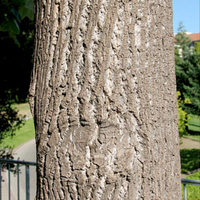Tulip Tree : Description
For someone that has little experience with tree identification the leaves are the best place to start when it comes to this tree. The Tulip Tree is identifiable most easily from its leaves because they are unlike any other tree species and slightly resemble a tulip flower (so remember, tulip shaped leaves=tulip tree. Pretty easy!) The leaves are simple, alternate, and are usually between four to six inches long and have four lobes. The lower two lobes are wider than the two upper lobes. The leaves are green and shiny and have a yellowish tint in autumn.
Along with the leaves, the flowers of the Tulip Tree are another key piece for identification. The flowers have nine green or yellow tepals, which is “a division of the perianth of a flower in which the sepals and petals are indistinguishable.” They also have an orange band on the inside of the flower. The Tulip Trees flowers are beautiful and are particularly striking when in full bloom, and resemble that of a tulip flower. The tree produces cone-like fruits as well. These cone-like fruits are approximately three inches long and taper towards the end. Seeds are encapsulated in the fruit and are a food source for many small animals that reside near these trees like squirrels, mice and birds. Both the flowers and the fruits of the Tulip Tree start producing when the tree is around fifteen to twenty years old.
The bark of this tree is also useful in identification. The bark is a dark grey color and as the tree ages over time the bark becomes more brown with visible furrows across the trunk of the tree.



